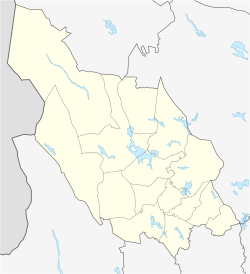Avesta (locality)
| Avesta | |
|---|---|

Avesta in October 2010
|
|
| Coordinates: 60°08′44″N 16°10′06″E / 60.14556°N 16.16833°ECoordinates: 60°08′44″N 16°10′06″E / 60.14556°N 16.16833°E | |
| Country | Sweden |
| Province | Dalarna |
| County | Dalarna County |
| Municipality | Avesta Municipality |
| Area | |
| • Total | 13.91 km2 (5.37 sq mi) |
| Elevation | 89 m (292 ft) |
| Population (31 December 2015) | |
| • Total | 22,781 |
| • Density | 1,109/km2 (2,870/sq mi) |
| Time zone | CET (UTC+1) |
| • Summer (DST) | CEST (UTC+2) |
| Postal code | 774 xx |
| Area code(s) | (+46) 226 |
| Climate | Dfb |
| Website | Official website |
Avesta is a locality and the seat of Avesta Municipality in Dalarna County, Sweden, with 22,781 inhabitants in 2015.
The name is first found in 1303 as "Aghastadhum". Aghe is of similar origin as the word å, meaning stream, in this case the Avestafors, a tributary of the river Dalälven. Stadhum was dative plural of a word of similar origin as , or farm.
In the Scandinavian Middle Ages there was a blast furnace at the location. In 1636 the construction of a giant copper mine was initiated near the Avesta fors.
The town Avesta received partial privileges in 1641 as a town under the city of Falun, and in 1644 a copper mint was built. However, the privileges were withdrawn in 1688 due to complaints of competition from its neighbour, mainly Falun. Copper coins were continued to be minted until 1831, and the copper works was in function until 1869.
Full city rights were regranted in 1919. The designated coat of arms depict the signs for copper and iron.
The town is located by the Dalecarlia River (Dalälven).
The railway junction Krylbo is situated in Avesta.
The following sports clubs are located in Avesta:
...
Wikipedia


